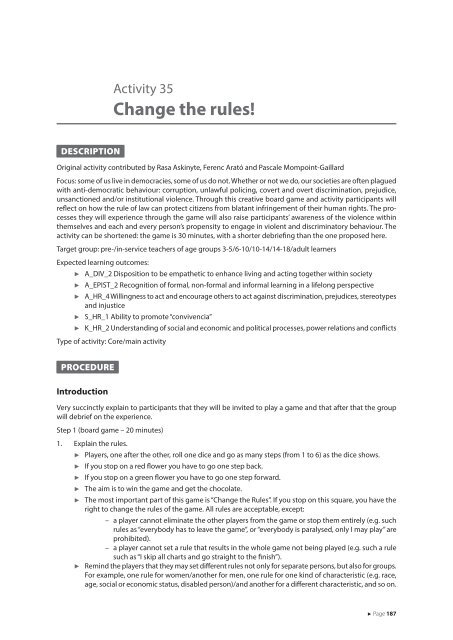TASKs for democracy
4NYw4W
4NYw4W
Create successful ePaper yourself
Turn your PDF publications into a flip-book with our unique Google optimized e-Paper software.
Activity 35<br />
Change the rules!<br />
DESCRIPTION<br />
Original activity contributed by Rasa Askinyte, Ferenc Arató and Pascale Mompoint-Gaillard<br />
Focus: some of us live in democracies, some of us do not. Whether or not we do, our societies are often plagued<br />
with anti-democratic behaviour: corruption, unlawful policing, covert and overt discrimination, prejudice,<br />
unsanctioned and/or institutional violence. Through this creative board game and activity participants will<br />
reflect on how the rule of law can protect citizens from blatant infringement of their human rights. The processes<br />
they will experience through the game will also raise participants’ awareness of the violence within<br />
themselves and each and every person’s propensity to engage in violent and discriminatory behaviour. The<br />
activity can be shortened: the game is 30 minutes, with a shorter debriefing than the one proposed here.<br />
Target group: pre-/in-service teachers of age groups 3-5/6-10/10-14/14-18/adult learners<br />
Expected learning outcomes:<br />
<br />
<br />
<br />
<br />
<br />
A_DIV_2 Disposition to be empathetic to enhance living and acting together within society<br />
A_EPIST_2 Recognition of <strong>for</strong>mal, non-<strong>for</strong>mal and in<strong>for</strong>mal learning in a lifelong perspective<br />
A_HR_4 Willingness to act and encourage others to act against discrimination, prejudices, stereotypes<br />
and injustice<br />
S_HR_1 Ability to promote “convivencia”<br />
K_HR_2 Understanding of social and economic and political processes, power relations and conflicts<br />
Type of activity: Core/main activity<br />
PROCEDURE<br />
Introduction<br />
Very succinctly explain to participants that they will be invited to play a game and that after that the group<br />
will debrief on the experience.<br />
Step 1 (board game – 20 minutes)<br />
1. Explain the rules.<br />
<br />
<br />
<br />
<br />
<br />
<br />
Players, one after the other, roll one dice and go as many steps (from 1 to 6) as the dice shows.<br />
If you stop on a red flower you have to go one step back.<br />
If you stop on a green flower you have to go one step <strong>for</strong>ward.<br />
The aim is to win the game and get the chocolate.<br />
The most important part of this game is “Change the Rules”. If you stop on this square, you have the<br />
right to change the rules of the game. All rules are acceptable, except:<br />
– a player cannot eliminate the other players from the game or stop them entirely (e.g. such<br />
rules as “everybody has to leave the game”, or “everybody is paralysed, only I may play” are<br />
prohibited).<br />
– a player cannot set a rule that results in the whole game not being played (e.g. such a rule<br />
such as “I skip all charts and go straight to the finish”).<br />
Remind the players that they may set different rules not only <strong>for</strong> separate persons, but also <strong>for</strong> groups.<br />
For example, one rule <strong>for</strong> women/another <strong>for</strong> men, one rule <strong>for</strong> one kind of characteristic (e.g. race,<br />
age, social or economic status, disabled person)/and another <strong>for</strong> a different characteristic, and so on.<br />
Page 187


